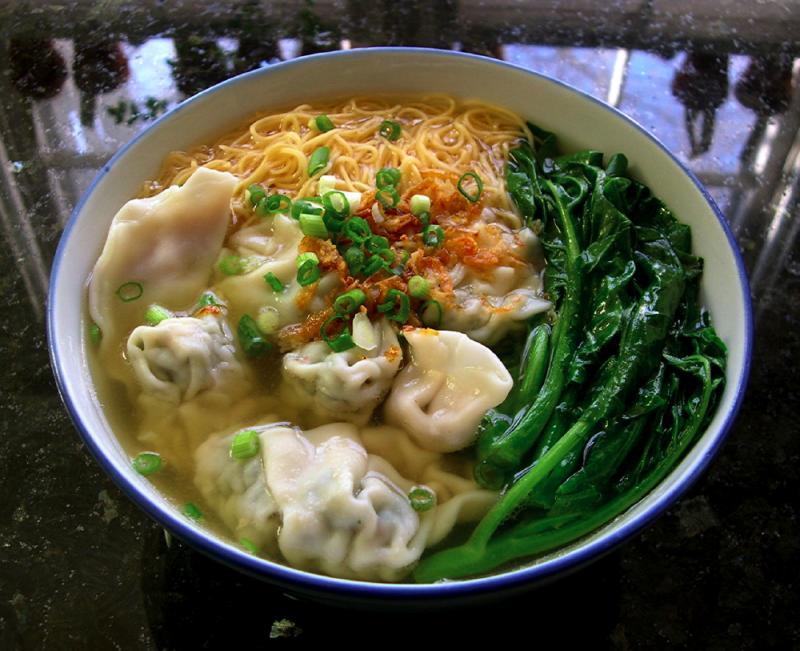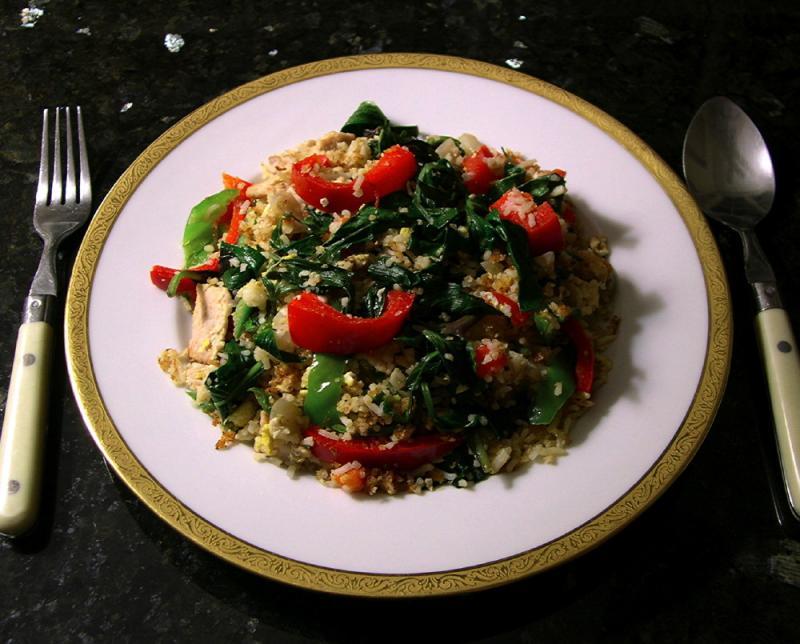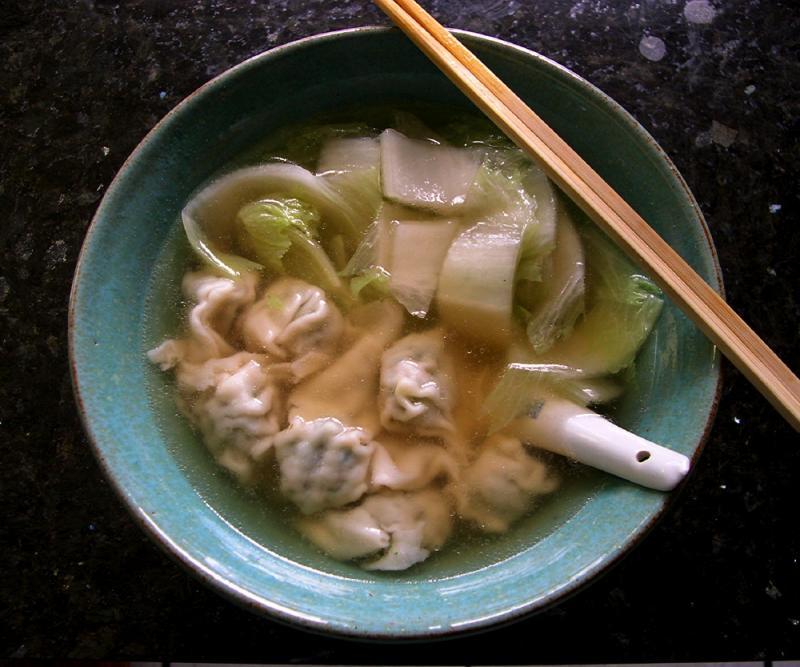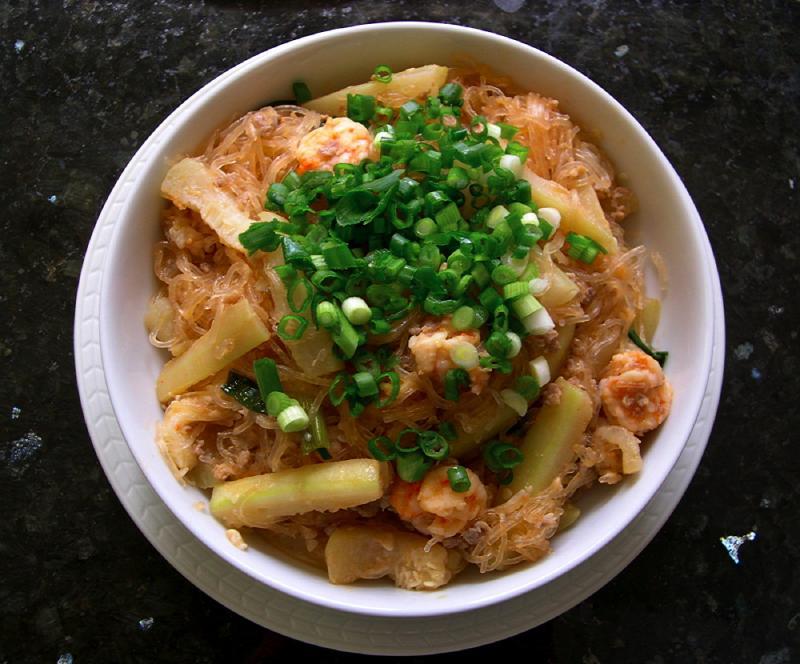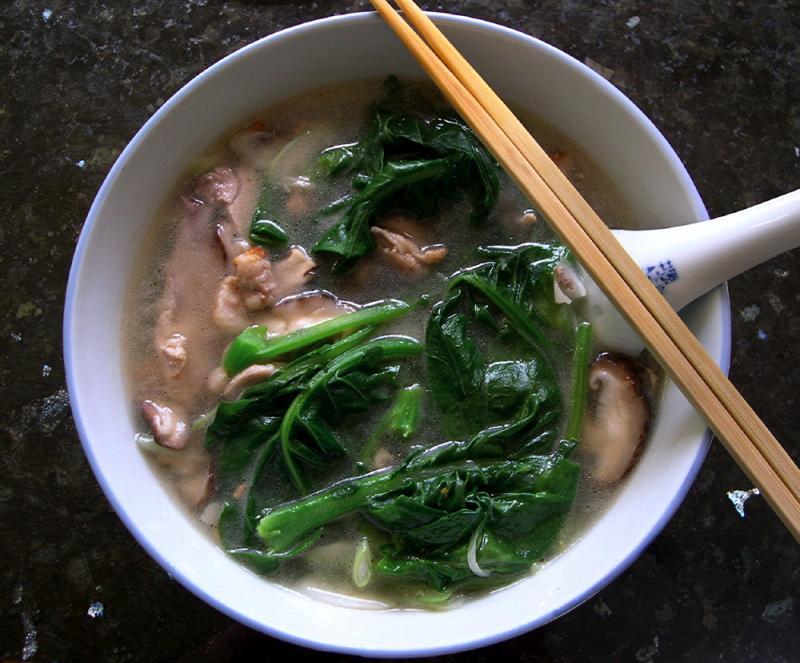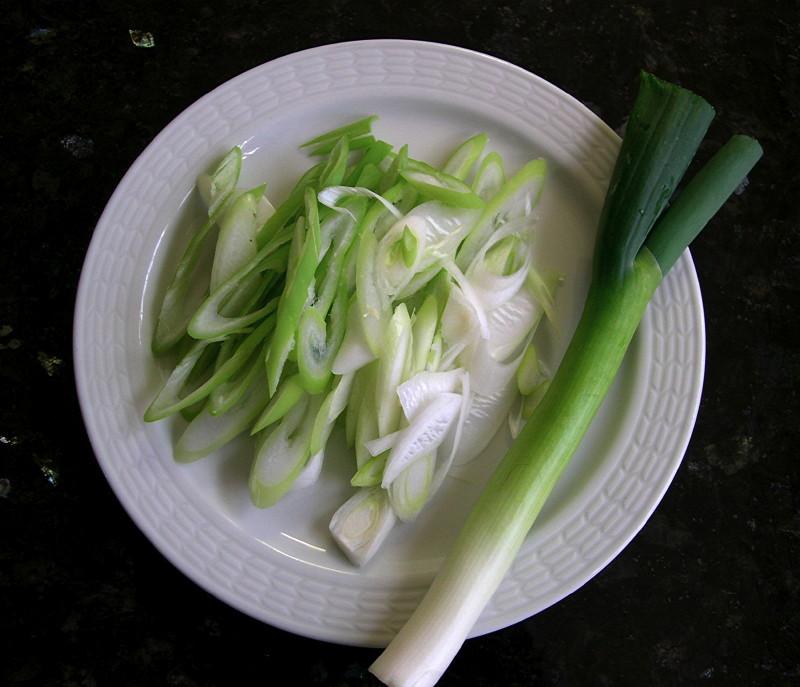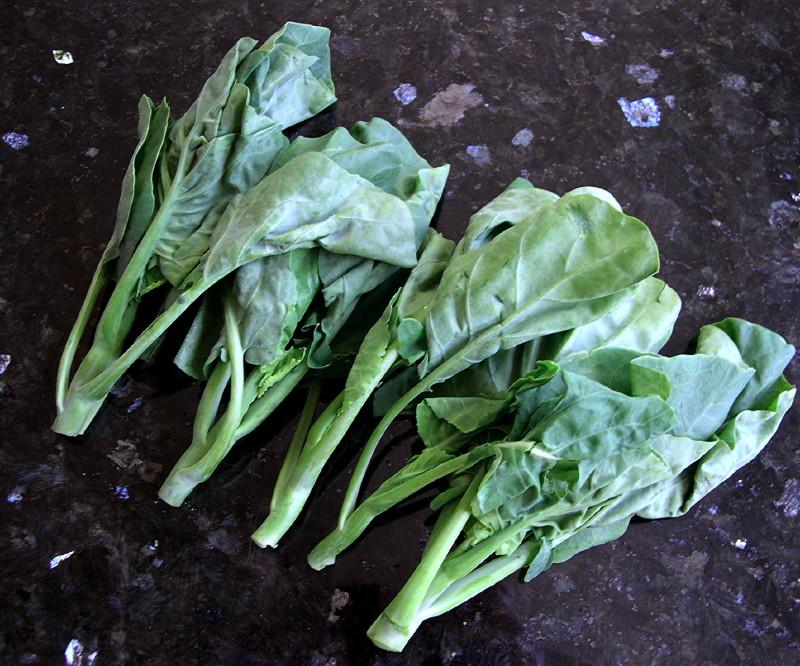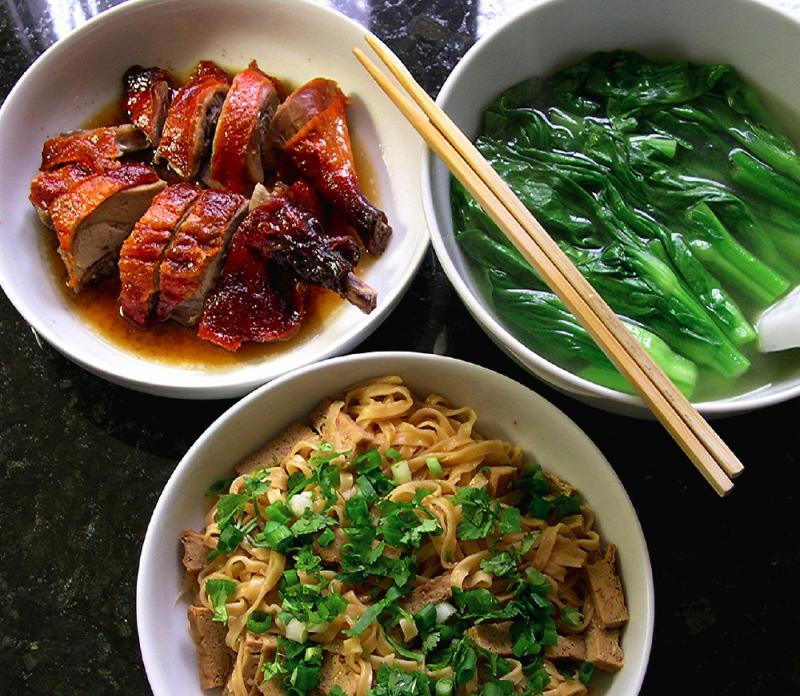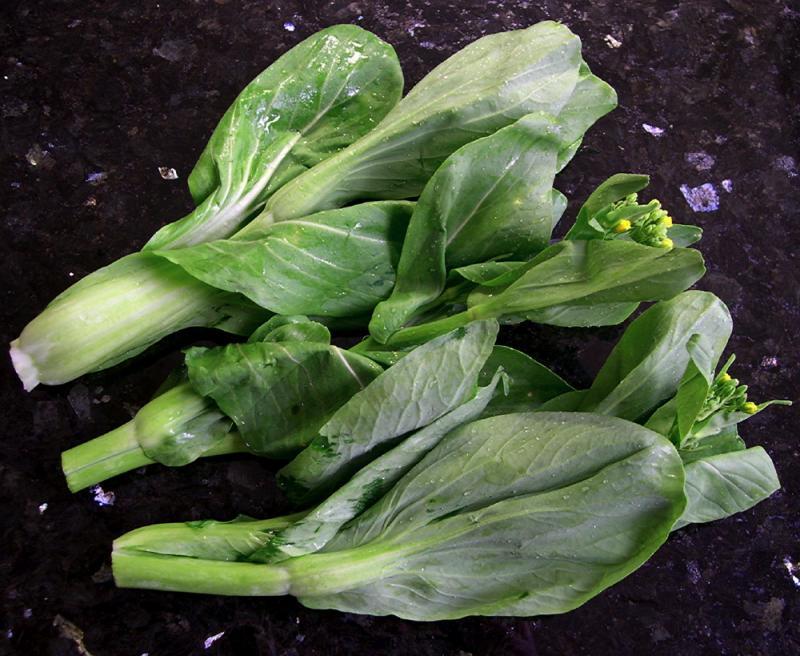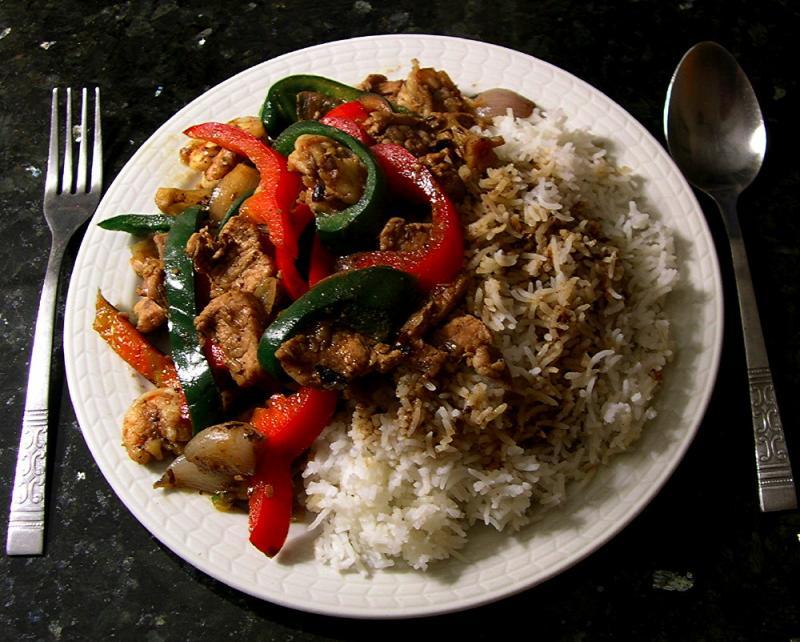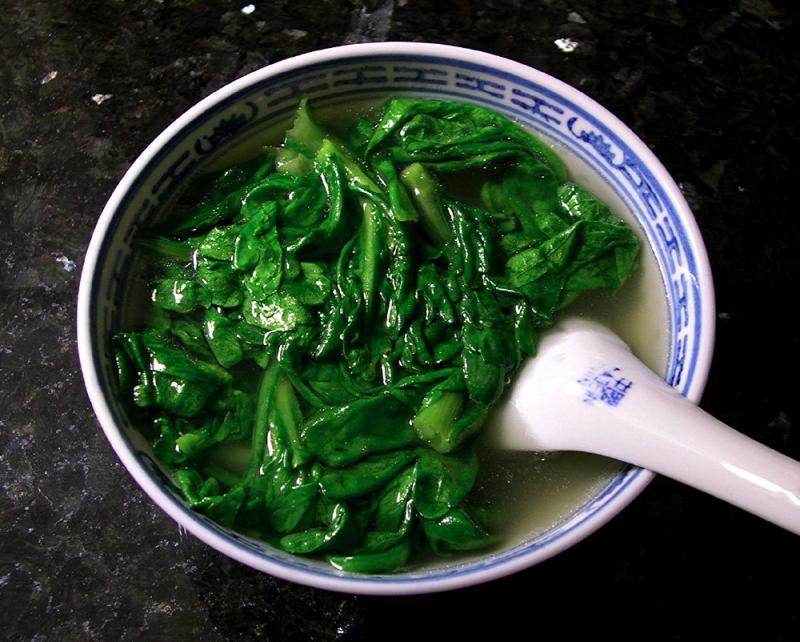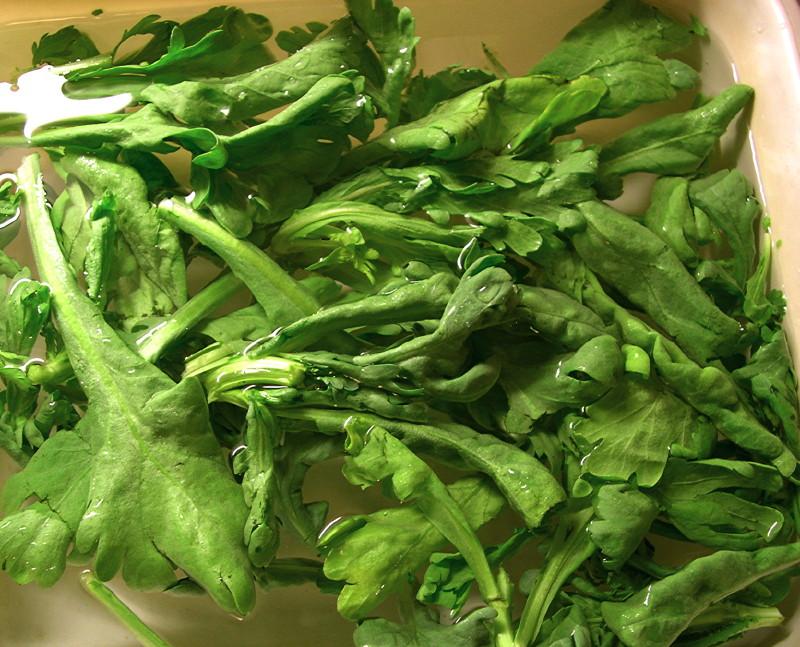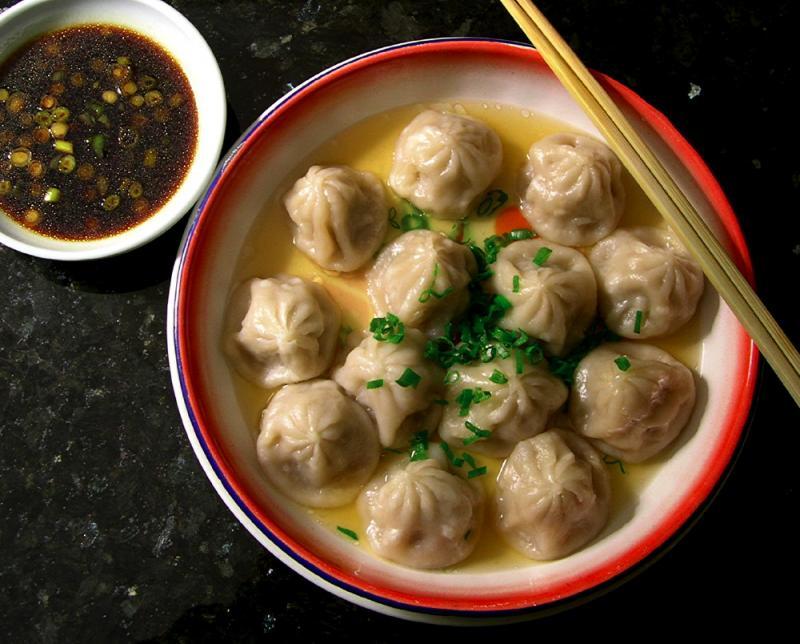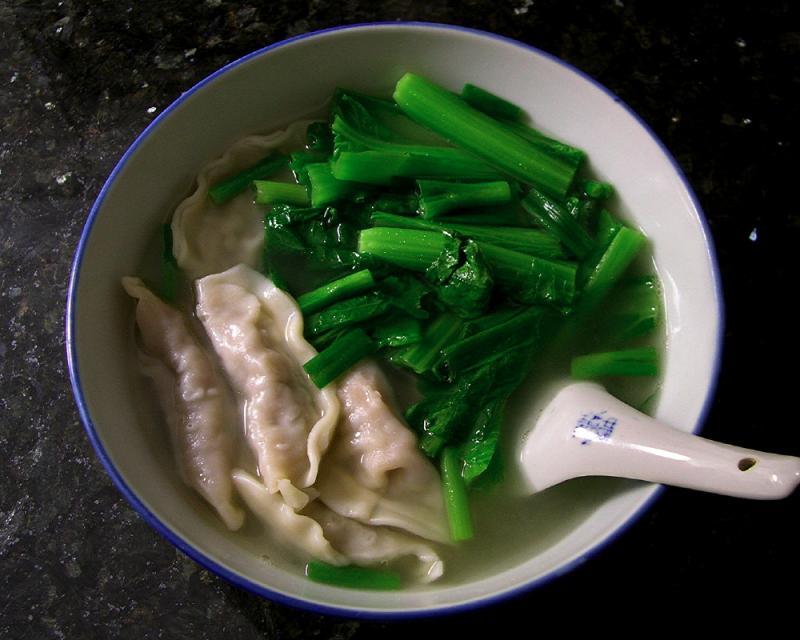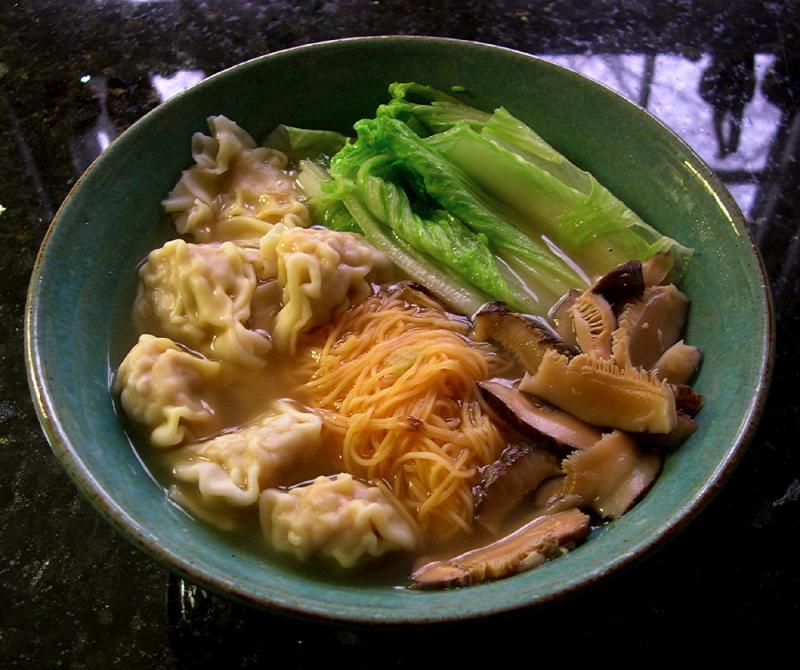-
Posts
3,810 -
Joined
-
Last visited
Content Type
Profiles
Forums
Store
Help Articles
Everything posted by huiray
-
hi Katie. you might find Elise's recipe for vegetable stock helpful: http://www.simplyrecipes.com/recipes/how_to_make_vegetable_stock/ if you're using celery, consider also using the leaves. they add a subtle herbal flavor that enhances almost any dish where celery appears in. you don't need much -- a tablespoon or two of chopped leaves is sufficient. there are plenty of winter vegetarian soups that don't use pureed squash or pumpkin as a main ingredient. below are links to two I did recently. Minestrone Invernale (winter minestrone) -- http://kitchenseasons.com/2012/12/26/minestrone-invernale/ . Although squash does appear as an ingredient, you can omit it and the soup will be fine. Pasta e Ceci (pasta and chickpeas) -- http://kitchenseasons.com/2013/02/06/pasta-e-ceci/ . Btw, this recipe is intentionally "open-ended", meaning that precise quantities aren't provided. Regarding using celery - try using Chinese celery instead of Western celery. It's stronger and more assertive in taste. ------ On a more general note (and after reading yet more recent posts on how many folks (in the USA, anyway) including some on eG seek out intense, deep, complex flavors etc and find a lot of food of various traditions or elsewhere lacking in flavor [including classic Cantonese ;-) ] I wonder about the taste preferences and palates and "taste-bud sensitivities" or "taste-bud calibrations" [so to speak] of folks in a general sense and about the genetic phenotypes (if any) or learned acculturations (if any) involved... For example, one notes that even something like salt sensitivity and "salt requirement" (or sugar) (etc) is at least partially "learned" and differs from many Mid-Western areas and North-East areas in the US; and folks who relocate from one of these areas to the other have been known to "alter" their salt (or sugar) sensitivity and preference over time. Just thinking out loud. (...and we are not even talking about chiliheads...) (...or the related question of why many - but certainly not all - Caucasians seem to greatly prefer Szechuanese food over Cantonese food, even pronouncing the latter "tasteless"...)
-
Some soups I've made recently (soupy noodles included): Winter melon & beef short ribs soup. Full post: http://forums.egullet.org/topic/143989-lunch-whatd-ya-have-2012/page-5#entry1908111 "Shui Gow Ngap Tong Meen". Full post: http://forums.egullet.org/topic/143989-lunch-whatd-ya-have-2012/page-5#entry1908265 Phở. Full posts: http://forums.egullet.org/topic/143989-lunch-whatd-ya-have-2012/page-5#entry1908520 and http://forums.egullet.org/topic/143989-lunch-whatd-ya-have-2012/page-5#entry1908630 Salmon & tuna soup, with various stuff. Full post: http://forums.egullet.org/topic/143989-lunch-whatd-ya-have-2012/page-6#entry1909644 Pork & shiitake mushroom wonton (home-made) soup. Full post: http://forums.egullet.org/topic/143989-lunch-whatd-ya-have-2012/page-6#entry1909650 Beef & veggie "stew" (soup). Full post: http://forums.egullet.org/topic/143989-lunch-whatd-ya-have-2012/page-6#entry1909817 Snow fungus, scallion, cilantro & celery soup. Full post: http://forums.egullet.org/topic/143989-lunch-whatd-ya-have-2012/page-6#entry1910081 Pork spare rib, shiitake mushroom & daikon soup. Full post: http://forums.egullet.org/topic/143989-lunch-whatd-ya-have-2012/page-6#entry1910081 Shrimp & pork wonton (Home-made) wonton soup w/ wonton noodles & "Char-siu". Full post: http://forums.egullet.org/topic/143989-lunch-whatd-ya-have-2012/page-7#entry1910389 Snow fungus & button mushroom soup. Full post: http://forums.egullet.org/topic/143989-lunch-whatd-ya-have-2012/page-7#entry1910667 "Chinese okra", snow fungus, shiitake mushroom & Chinese fish cake soup. Full post: http://forums.egullet.org/topic/143989-lunch-whatd-ya-have-2012/page-7#entry1911234 Lotus root & pork spare ribs soup. Full post: http://forums.egullet.org/topic/143989-lunch-whatd-ya-have-2012/page-8#entry1911915 Wood-ear fungus, snow fungus & scallion soup. Full post: http://forums.egullet.org/topic/143989-lunch-whatd-ya-have-2012/page-8#entry1912014 Soup w/ baby green tips, fresh shiitake, pork, Japanese scallion. Full post: http://forums.egullet.org/topic/143989-lunch-whatd-ya-have-2012/page-8#entry1912753 Vegetable soup in chicken broth. Full post: http://forums.egullet.org/topic/144211-breakfast-2013/page-3#entry1910843 Also: Edible chrysanthemum (large-leaved) in broth. Full post: http://forums.egullet.org/topic/143989-lunch-whatd-ya-have-2012/page-8#entry1912014 Taiwan "choy sum" in broth. Full post: http://forums.egullet.org/topic/143989-lunch-whatd-ya-have-2012/page-8#entry1912569 Various other commercial wonton/shui-kow soups w/ or w/o noodles. See, e.g.: http://forums.egullet.org/topic/144211-breakfast-2013/page-3#entry1912279 ; http://forums.egullet.org/topic/144211-breakfast-2013/page-3#entry1912908 ; http://forums.egullet.org/topic/144603-dinner-2013-part-2/#entry1911050 ; http://forums.egullet.org/topic/143989-lunch-whatd-ya-have-2012/page-8#entry1912878 .
-
Only the top layer goes brown; it will still be (brighter) green underneath the surface layer, unless it has been around for a really long time (fridge). I freeze the larger part of bigger batches I make - with cheese already in - in glass Ball jars. No, they've never cracked in my experience. I use a hard (or metal) spoon to scrape out what I need from a jar for subsequent times I want some pesto. I don't even really "rewarm" the scrapings - usually I'll leave it for a short while in the intended serving bowl (e.g. while boiling pasta) and they thaw out enough. Sometimes, the HOT wet pasta is dumped onto the cold still-semi-frozen pesto and the heat/moisture & tossing does the trick sufficiently and is good enough for me.
-
Another bowl of wonton - shui kow mein, in broth. Pork, shrimp & Chinese celery wontons [Wei Chuan]; pork, cabbage, shrimp & mushroom Shui Kow [Prime Food]; "Veggie sprouts/baby veggie tips" ["菜苗"; Yale Cantonese: choi3 miu4; these were baby kai-lan tips]; skinny wonton noodles [Twin Marquis].
-
"Easter eggers"....like these? :-) Is your chicken-raising in an urban or rural setting? I pick up these blue/green colored eggs on occasion at local Farmers' Markets but they're not frequently found even there. Fun eggs.
-
Dinner on Wednesday: Fried rice - with halved garlic cloves, sliced pork, salt, eggs scrambled in situ, 2-day old rice, shallots, sliced sweet red bell pepper & hot long green chillies, trimmed Thai basil. Added in that order.
-
Simple quick and tasty lunch today (Wednesday) - pork & Chinese spinach wontons [Wei Chuan] and large-chopped Taiwanese-type long Napa ("Wong Nga Pak") cabbage in broth. The wontons were nice and silky.
-
OK, thanks. I thought they were gai lan/kai-lan tips, but wasn't certain - so I left it at "kale" (which gai lan is). Yes, they are nice, aren't they!
-
ScottyBoy, looks nice. Did you make it there or bring it with you into the country? No customs/import issues?
-
I think baked chips simply cannot match the real ones deep fried in oil (or lard!) and seasoned w/ salt insofar potato chips (or crisps, in the UK - where the OP appears to be located) are concerned. Rice crackers (especially w/ sesame seeds) are OK, but they need to have been done properly, not in those "oh-so-healthful" ways. I'd just eat the saturated-fat+salt stuff, just less of them - like, not a bag a day everyday. Y'know what they say, "Everything in moderation".
-
Lunch today: • Soup w/ baby green tips, fresh shiitake, pork, Japanese scallion. A big, fatty pork chop (Western cut) was dismembered, the fat layer on the outside of the meat cut out and chopped up, the meat separated from the bones and the meat cut into chunks and sliced against the grain. The chopped-up fat + bones were sautéed till the fat pieces were “browned” and liquid lard had been generated, then the mix quenched w/ water; salt was added and the soup simmered for a bit. The sliced pork meat was then added in followed after a short while by trimmed “veggie green tips”¶; then by sliced fresh flower-patterned thick-cap shiitake mushrooms (“Far Koo”). A brief simmer was done; then thinly-sliced (slantwise on the bias) “Japanese onion (scallion)”§ tossed in and the heat was turned off. ¶ These were called “菜苗” in my local Chinese grocery but that term is really just a generic term for young sprouts/young shoots of almost any kind of veggie. The ones I picked up and used today look like young kale shoot tips. § They were labeled as such in my local Chinese grocery. They're not quite “negi”. • Cellophane noodles w/ shrimp & minced pork. Whole (defrosted) shrimp were de-shelled & de-headed, deveined, reserved. The shells & heads (with lots of head cream) were sautéed w/ chopped smashed garlic and finely sliced fresh ginger w/ some salt; quenched w/ water, simmered for a while, then poured through a sieve to furnish a nice shrimp stock w/ lots of orange “shrimp cream” oil. Finely chopped smashed garlic & finely sliced ginger were sautéed in peanut oil, minced somewhat-fatty pork added in & the mix tossed around a bit; seasoned w/ salt, a bit of fish sauce, some light soy sauce, a bit of mirin; then sliced “chit kua”/Chinese ”hairy gourd” [de-skinned, of course] tossed in, the mix banged around for a bit, then quenched w/ the reserved shrimp stock & the mix simmered for a short while. The reserved shrimp were then added in followed by several bundles of “cellophane noodles” (“Fun See”) and the whole stirred and simmered till done and much of the liquid had been absorbed by the noodles. This was a riff on what would otherwise have been “Tai Yee Ma Kar Lui”,† where I would normally use dried shrimp (“Har Mai”) and neither ground pork nor shrimp stock would have been used. I must say I did not care for this riff. I prefer the original “Tai Yee Ma Kar Lui” using dried shrimp and with minimal condiments. Perhaps if super-fresh shrimp were available to me it might have been different. † See here and here for previous posts on this dish. Pics of the "Japanese onion" and the “菜苗” :
-
I made some comments on that blog page back in 2010. :-) [scroll down the page...] I've never *particularly* liked the "turning the heat off and leaving the chicken to sit in the stock" technique. It can turn out to be quite variable depending on the chicken, how much water you used.how much you needed to cover the chicken/size of pot/width of pot vs width of chicken, how long it takes to bring the stock back up to a boil after the "sitting period", etc. I do use it, but alternate with the constant simmer method as well. The ice-water treatment I also often leave out - for my taste it removes too much gelatin (which I like) from the juices that "puddle" slightly under the chicken when allowed to rest on a plate. The sesame oil rub treatment - that can be iffy - depending on which type or brand of sesame oil you use. The "roasted" type is overpowering and overwhelms everything. I find a simple veggie oil treatment is actually much better (for my taste). I frequently dispense w/ the oiling treatment especially if I had added in extra chicken fat (for the subsequent use of the stock + fat to make the chicken rice for it - in terms of "Hainanese Chicken Rice"). Nowadays I even sometimes dispense with the additional 10-minute simmer or shorten it (when doing the constant simmer alternative) and take the chicken out when the temperature reads about 160-165ºF using one of those pie-face stick-type thermometers. The marrow in the bones may still be pink - that's fine by me.
-
Lunch on Sunday: • Taiwan Choy Sum (see pic) in broth. • Wide wonton noodles (Twin Marquis) tossed w/ a sauce of a sauté of sliced garlic in peanut oil, sliced pre-fried tofu (Nature's Soy), oyster sauce (Lee Kum Kee), jozo mirin (Morita). • Cantonese roast duck (store-bought), re-warmed.
-
Heh. The frozen dumplings (from Prime Food) aren't as good as what you might make fresh yourself - but, y'know what? I don't have the inclination or energy to always make them myself and these (and others from other manufacturers) are decent in my view and do fit the bill for a decent meal. They do vary in terms of which are "better" as compared with competing brands. For example, the Prime Food wontons I think are not as "silky" as the ones from Wei Chuan, in my view. The "shui kow" from either (or from O'Tasty) are similar to each other, not bad - but again, stuff you make yourself might be better, of course. XLB - certainly the ones made fresh would be better - but these will do in a snap if I don't manage to get to a place for freshly-made ones. Keep in mind the ones I had were definitely "old" ones - even for packaged frozen stuff. ETA: Whoops, that should have been "pork, scallop & shrimp "shui kow" dumplings" in my initial post...
-
Early lunch on Saturday (before dashing out the door to take in Francesca da Rimini in HD Live) was leftovers from dinner the previous night. Pork slices & shrimp stir-fried w/ sliced Poblano peppers, red bell pepper, halved shallots, and black bean - garlic sauce (Lee Kum Kee). Served on white rice (Basmati). Also large-leaf edible chrysanthemum (Chrysanthemum coronarium; "Dai Choy Tong Ho"; see here, here, here, here for other images) in chicken broth. Pics from the previous night's dinner: The trimmed tong ho soaking in water:
-
I was clearing some space in my freezer for new stuff and found two old packs - of mini pork & shrimp dumplings (xiaolongbau-type; 小籠湯包) [Prime Food]; and pork, scallop & "shui kow" dumplings (水餃) [Wei Chuan]. Sooo...dumpling night it was. I had the steamed XLB (they leaked, unfortunately) with a dipping sauce thrown together from mixing some "aged soy sauce" [Kimlan], light soy sauce ("sang chau") [Kimlan], Chinkiang vinegar [Jiangsu Hengshun], a bit of veggie oil and finely chopped scallions. I had the "shui kow" (cooked separately in simmering water) in simple chicken broth with trimmed hearts of "Pull Mustard" (see a previous post on them here) briefly simmered in the broth and scallions scattered in after "bowling" it. Heh, not a high-falutin' dinner by any means. :-)
-
It's a Korean H-Mart. In the USA DC area, I suppose, unless Hassouni clarifies it was in London or Beirut. There are 3 in MD in the northern suburbs of DC and 3 in VA across the Potomac not too far from DC. They are more likely to sell Japanese products rather than Chinese products when not selling Korean products. I'd say they are negi. See these links (you'll need to scroll down to see the pics and chit-chat in many of them): http://www.photoree.com/photos/permalink/735795-44124420092@N01 http://www.honolulumagazine.com/Honolulu-Magazine/September-2004/Savoring-the-negi/ http://www.gourmetsleuth.com/Dictionary/N/Negi-6471.aspx http://umamitopia.com/blog/article_182.html http://misoandyuzu.blogspot.com/2012/04/grilled-chicken-with-japanese-leek-salt.html http://madehealthier.com/2009/01/09/nijiya-market-in-hawaii/ http://pomaitest.wordpress.com/2010/04/20/more-ono-grindz-at-kcc-farmers-market/ http://tastyislandhawaii.com/2012/05/26/plate-lunch-prices-then-and-now/ http://www.alibaba.com/product-free/113419355/green_onion_EDO_SENJYU_NEGI_japanese.html etc etc. Nevertheless, if it is a negi, then it would still be Allium fistulosum - but the cultivar/variety that was developed/grown to become what is called "negi". I talked about them also in my post above. Chinese leeks of the sort being referred to here - if they have flat leaves (and not like the [partly collapsed] tubular leaves seen in Hassouni's pic) like what Fuchsia Dunlop says then they are not Allium fistulosum - but a variety (or subspecies? or cultivar?) of Allium ampeloprasum 'Leek Group' instead? (The common leek, Western type, would be Allium ampeloprasum var. porrum, a subspecies) Why not find a manager and ask him or her?
-
They seem to look like Allium chinense? Are they also known as "藠头"? Hmm, Baidu (Google translation) says "荞头" are "Allium chinenes" (sic) (G. Don) which might be a misspelling for "Allium chinense"... a search on the web shows both terms apparently referring to the same thing, but which is properly A. chinense. There is a separate Baidu entry for "藠头" but which does not identify it by the Latin binomial name. There appear to be Chinese companies that offer "Allium chinenes" for sale (and export?) (one example). The web images for "荞头" do look just like the images for "藠头" and in looking around I also saw this article that describes the two as being synonymous; but are they separate plants in your understanding? Interestingly, the MMPND entry for Allium chinense gives "茭头" (but not "荞头") as one of the Chinese names; while the Baidu entry for "茭头" identifies it as "Allium chinenes G. Don" too, as with "荞头", and gives "藠头" as one of the synonyms for it but not "荞头". I am genuinely curious about the matter and would appreciate comments! If they are A. chinense, then they are also grown in Japan & SE Asia; and Korea, I imagine.¶ Or at least one (or more) cultivars/varieties of it. (The Baidu article on "荞头" I referred to above does say that it is also cultivated in Japan, N & S Korea, Russia and other countries) I mentioned their cultivation in E/SE Asia in my post above. In Japan they are known as rakkyo. These are also the Japanese "pickled scallions" I pick up at my local Chinese grocery and which I used in making "Yee Sang". :-) In SE Asia I remember eating them (or something very similar!) while growing up but infrequently. Typically they were stir-fried with various stuff; including some preps containing chillies or sambal belachan IIRC. I vaguely remember their taste as somewhat like what you describe. Here's a Malaysian blog about these shallots/scallions; and a post from a blogger who visited her friend's father in Hunan and had a meal that included "藠头". ¶ Also in the USA, but not widely I think. See this and this as two examples. I don't consciously remember seeing them in my local grocery, but might have seen them in Chicago...
-
Well, "negi" is the Japanese term for Allium fistulosum, which I mentioned in my post above (1st paragraph after "tid-bits"). Take a look at the images I linked to - do those in your H-mart look like them? Koreans often use the Japanese term for the same stuff they sell as the Japanese. Don't forget they grow and eat many things the Japanese and Chinese do, as I'm sure you know. :-)
-
Pork, shrimp, cabbage & mushroom wontons [Prime Food] with wonton noodles & "long Napa" cabbage. In soup made from sautéed sliced ginger & halved garlic cloves quenched w/ chicken broth & simmered w/ dried shiitake mushrooms & dried anchovies; decanted when done. The garlic and some of the shiitake (sliced) were recovered and added in to the dish.
-
Variety 'Shimonita'? Like this one from Sutton Seeds in the UK? If it is and it is correctly labeled/identified, then it looks like it is a variety of Allium fistulosum and you will probably never get big bulbs but fatter and fatter stems on growing it longer and longer. :-) http://www.gourmetseed.com/product/ON06/Onion-Shimonita.html http://www.kitazawaseed.com/seed_312-14.html http://www.territorialseed.com/product/9891/420 http://www.tozerseedsamerica.com/products/onion-shimonita-no25/ http://www.seedratings.com/item/shimonita-onion http://myfolia.com/plants/1152-bunching-onion-allium-fistulosum/varieties/16438-shimonita
-
The three terms cited here do tend to be used interchangeably in my experience too, with the variations between usage mentioned by others depending on where you are and the context. "Bunching onions" is also used in many places especially to refer to the non-bulbing types. I myself use "scallion" and "green onion" somewhat interchangeably too, although I tend to think of "Spring onion" as the definitely bulbous types especially available in spring (what else) as the immature growths of "normal" common onion-onions, typically Allium cepa. It might be useful to gather some tid-bits here. What one should look for if one specifically wants the non-bulbing type is Allium fistulosum a.k.a. "Welsh Onion". (Google images here), also "negi" as they are known in Japan; these approach small leek size (and even larger - see images for "大蔥" below) as they are allowed to grow on, although they are not "leeks" as are known in the USA or the UK. (Also, "Cebolinha" in Portuguese, so I gather) To the O.P. - are these what you mean when you say they remind you of leeks? Those would be what are also "leeks" in the US and in Europe, too...and different from scallions or green onions or spring onions. A. fistulosum is also commonly grown elsewhere in East Asia; Chinese suppliers (like this one; or this American-owned holding company growing in Kunming, Yunnan offers these) also provide beautiful straight non-bulbing extensively white-bottomed (from high mounding) "scallions" too, besides what is grown in Japan. These are different from Allium chinense (images) which are also grown in E/SE Asia. Joy Larkcom's book "Oriental Vegetables" has a section on "Oriental bunching onion" which addresses many of these issues and also identifies the species usual in China ("蔥"; Yale: chung1 in Cantonese) as Allium fistulosum. BTW what the O.P. reports as "xiao cong" and "da cong" from Dunlop's book presumably must be "小蔥" (Yale Cantonese: siu2 chung1) and "大蔥" (Yale Cantonese: daai6 chung1) respectively. Note the difference in sizes (from the images) due to havesting when immature and when fully mature! On the other hand, Shiu-ying Hu in "Food Plants of China" assigns "小蔥" as Allium ledebourianum (pg 313) but does not describe its cultivation, only that it is found in alpine meadows and that it is bulbous. The images from a web search for this species also seem not to correspond with what would be cultivated and used extensively in the cuisine? He does assign "大蔥" to Allium fistulosum (pg 312) and describes it as expected for the non-juvenile examples of it seen in the other images for this. The MMPND database at the U. of Melbourne does not list "小蔥" as a Chinese term for Allium ledebourianum but lists "大蔥" as a Chinese term for Allium fistulosum and also that it would be simply known as "蔥". Heh. There are hybrids between Allium cepa and Allium fistulosum, and these can furnish the straight-sided non-bulbing scallions too, an example being Green Banner (Example here) or Baja Verde (example here) which possibly might be slightly more bulbous? The wikipedia article (FWIW) says that most scallions/green onions/"salad onions"/bunching onions grown in the West tend to be Allium cepa var. cepa. I wonder if the hybrids are really more widely grown commercially than that statement suggests. In my local Chinese grocery (in Indiana, with US-based veggie suppliers) I've found almost-wholly-straight-sided "scallions" as well as slightly bulbous ones, at different times, with the slightly bulbous ones predominating by far. This would seem to tend to agree with Allium cepa var. cepa being the type that is mainly grown around here. This company offers A. cepa seeds with an accompanying photo of straight-sided non-bulbing scallions (hmm) although the detailed info talks about growing them on to full-sized onion-onions... One distinguishing characteristic with the young plants of both species (both used as scallions/ green onions/etc) seems to be that A. fistulosum leaves would be hollow and circular in cross-section, whereas A. cepa leaves would be "flattened" on one side - again, in keeping with what I observe in the supplies of "scallions" in my local grocery (or Western groceries). I once found a grower at a local Winter Farmer's Market who offered slender, definitely entirely non-bulbing stuff which he identified as "true French scallions" (so he said) and not "chives" but I never saw him offer it again and in fact I haven't even gone back to that market this winter.
-
Yes, that's right, I'd forgotten that aspect. But what I had in mind when I asked that question was a comparison between what one found in terms of local produce as well as local foodstuffs (prepared or baked or cooked etc) between the Union Square green market and the "equivalent" local stuff found in indoor winter markets in NYC (including Chelsea Market).
-
Heh. I should try that if it's still available to see which side of the fence I come down on. http://www.alaskadispatch.com/article/mixed-reviews-alaska-pollock-mcdonalds-fish-mcbites http://www.huffingtonpost.com/2013/02/13/mcdonalds-fish-mcbites_n_2680255.html http://www.forbes.com/sites/marketshare/2013/03/12/mcdonalds-fish-mcbites-flounders-new-product-line-doesnt-hook-consumers/ Interestingly, the Fish McBites does not appear on the McDonald's website full menu... http://www.mcdonalds.com/us/en/full_menu_explorer.html
-
Chillies are also fruits. Perhaps what the question should be is whether "culinary dessert fruits" can be used. As differentiated from how tomatoes are vegetables in the culinary sense as it has been ruled.



